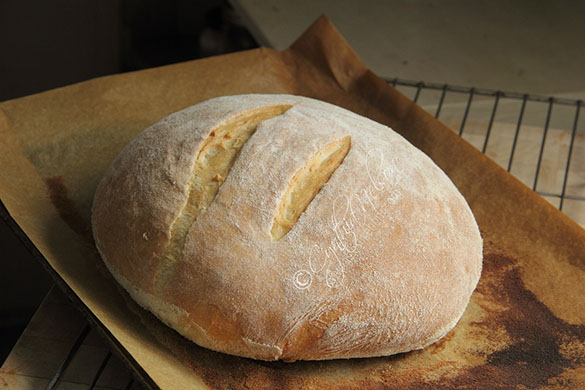While we hustle and bustle about setting Garlic Pork and Ginger Beer, making Pepperpot and baking cake days in advance, securing the ham and other traditional holiday goodies, please do not forget the bread. What I mean is this – don’t forget to include the baking of bread in all your food prep and cooking.
The holidays are a celebration of home cooking. From scratch home cooking. And it’s easy to cast aside the baking of bread for the holidays because there are so many bakeries around. For the most part, they’re good, for everyday eating, but for the holidays, make it extra special – bake your own bread. Homemade bread evokes all the things we love about the holidays – nostalgia and family; it has a way of feeding our souls in a way few other foods can. At its simplest and best is eating slices of warm bread slathered with butter. It is a taste of home. And isn’t that what we all crave at the holidays? A taste of home?

It’s a labour of love dedicating the time to carefully set Garlic Pork; we torture ourselves with the fragrant aroma of Pepperpot bubbling away on the stove, knowing that we have to let it cook over a few days to develop its full flavour and dark rich sauce. The ham, carefully scored, studded with cloves and glazed with our favourite jam, makes us giddy with happiness and impatient. We want to eat the ham now! Well, equally important to these 3 holidays favourites is the bread with which we will eat them. You want bread that is suitable to the task. You want bread that you can break into large pieces and dip into your Pepperpot to soak up the sweet, spiced sauce. You want bread that can support the generous and often thick slices of ham or chunks of Garlic Pork for that one-of-a-kind sandwich. Or perhaps, all you want is a good cheese sandwich or a thick slice of toast with butter or jam. Bread is life.
It does not matter what type of bread you make – traditional anise-seed bread, white bread, whole wheat or multigrain bread, just make some homemade bread for the holiday feasting. And while I know that it is easy to get caught up in the more fancy and attractive things you want to make for the holidays, bread is something that you can make ahead and freeze, if you so desire. However, I like the aroma of bread baking and warming the kitchen, so I tend to bake bread a few times over the holidays.
Today I am going to share with you a couple of recipes for homemade bread that even if you are new to bread baking, you can make. I often consider these two types of bread as introductory bread making. You’ll also have some options in terms of the types of flours you want to use, just in case all-white bread is not your thing.
Bread is essentially flour, water, yeast and salt. These days, instant yeast is easily available, so you do not need to trouble yourself with proofing active yeast. Secondly, one of the recipes is for a no-knead bread, so if kneading dough is not something you are comfortable doing, that is not a problem, you can still make bread.
Because the recipes for these breads are easy, if you like, you can test your bread-making skills this weekend or any time before the main holiday period so that when the time comes around, you are confident in your bread-making ability.
If you have questions, do not hesitate to inbox me: cynthia@tasteslikehome.org
Cynthia
No-Knead Bread
Yield: 1 large loaf
SPECIAL EQUIPMENT
1 (13 x 18-inch) baking sheet lined with parchment paper
INGREDIENTS
• 1 pound all-purpose flour, plus extra for dusting
• ½ tablespoon fine table salt
• 1 tablespoon sugar (brown or white)
• ¾ tablespoon instant yeast
• 1 ½ to 1 ¾ cups warm water (110 – 115 degrees F)
• Cornmeal for dusting
DIRECTIONS
1. Add the flour, salt, sugar and yeast to a large bowl and mix thoroughly.
2. Pour in 1 ½ cups water and stir to mix and form a thick wet dough. If you find that there is still flour in the bowl that has not been incorporated into the mass, then add the ¼ cup of water. Mix together for 30 seconds.
3 Cover the bowl with plastic wrap and leave in a warm place to proof/rise for 2hours or until more than doubled in volume.
4. Dust the lined baking sheet with cornmeal and set aside.
5. Generously dust a work surface with all-purpose flour.
6. Tilt the dough out of the bowl on to the floured work surface (use a rubber spatula or wooden spoon to help you get all the dough out of the bowl). Don’t worry, the dough will be very sticky and will spread.
7. Flour your hands well and lift the dough from one side to the middle, on to itself; now do the same with the other half for the dough (flour your hands again ifnecessary). Now flip the dough over, seam-side down.
8. Using your hands, tuck in the dough from the base (the part making contact with the surface) to form a large ball. Dusting your hands with more flour is necessary to do this part.
9. Once the ball has been formed, transfer it to the lined and dusted pan, placing it in the centre. Leave uncovered in a warm place to rise for 40 minutes.
10. After the first 20 minutes, preheat the oven to 450 degrees F with the rack in the middle.
11. At the 40-minute mark, transfer the risen dough to the oven and bake for 20 – 25
minutes. Check after 20 minutes and if the bread looks brown and the crust is solid and sounds hollow when tapped, remove from the oven, if not let cook for another 5 minutes.
Remove pan from oven and transfer bread to a wire rack to cool completely to room temperature before cutting.
NOTES
• If you do not have a baking sheet, use a large round pizza pan if you have one or 2 regular 9 x 5 loaf pans. However, if using loaf pans, cut the dough in half at direction # 7 and oil the pans well before adding the dough.
• You might find that during the baking of the bread there is the smell of somethingbeing burnt, don’t worry; it is just the cornmeal getting dark.
• If you do not want to make an all-white flour loaf, use half all-purpose flour andhalf wholewheat flour. Or, half all-purpose flour and half multigrain flour. Or half all-purpose flour and half fine semolina flour.
• Wholewheat, multigrain and semolina flours absorb more liquid, therefore use 1 and ¾ cups of water initially and add more as necessary.
• In place of water, whole milk can be used to make a richer bread.
No-Proof Instant Bread
Yield: 1 large loaf
SPECIAL EQUIPMENT
• 1 (6 quart) oven proof pot with lid OR
• 1 large oven proof bowl/dish of similar capacity
• Aluminum foil
INGREDIENTS
• 1 pound all-purpose flour, plus extra for work surface
• 3 level teaspoons instant yeast
• 2 tablespoons brown or white sugar
• ½ teaspoon fine table salt
• 2 tablespoons vegetable oil
• 1 to 1 ¼ cups warm water (110 – 115 degrees F); you may need more or less depend
ing on your location and quality of flour
DIRECTIONS
1. Mix together the flour, sugar, yeast and salt in a large bowl. Make a well in the
center.
2. Pour oil and water into flour and mixt to form a dough. Turn the dough on to a
floured work surface and knead for 12 minutes until smooth.
3. Shape or braid the dough however you like.
4. Lightly brush the pot, dish/bowl whichever you are using and transfer the dough.
Cover the pot with lid or cover the bowl/dish with aluminum foil creating a dome
effect which will give the bread room to rise and grow. Place the pot, bowl/dish in
the oven and let rest for 10 – 20 minutes (optional).
5. Turn on the oven to heat to 400 degrees F. Bake covered for 40 minutes then
remove the lid/cover/foil and bake for 5 minutes or until the bread is nicely
browned. Remove from the oven and rest for 8 – 10 minutes before removing from
pot, bowl or dish. Cool on a wire rack to room temperature before cutting into the
bread.
NOTES
• Baking time begins when the pot is added to the cold oven and the heat is immedi
ately turned on. There is no pre-heating of the oven.
• If you do not want to make an all-white flour loaf, use half all-purpose flour and
half whole wheat flour. Or, half all-purpose flour and half multigrain flour. Or half
all-purpose flour and half fine semolina flour.
• Whole wheat, multigrain and semolina flours absorb more liquid, therefore use 1
and ¼ cups of water initially and add more as necessary.
• In place of water, whole milk can be used to make a richer bread.
• For anise-seed bread, add ½ tablespoon anise-seed to the warm water (or milk if
using) and let steep for 10 minutes before adding to make dough (direction # 2).









